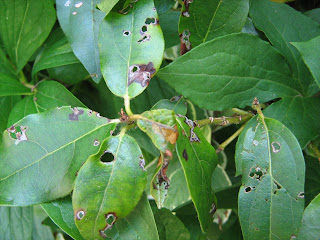ABC Wednesday 4: V is For...

... Viburnum Beetle
Just before we went on holiday my friend L emailed me with the following question:
...my guelder rose [aka Viburnum opulus - VP] is being eaten by small black and white caterpillars, about 5mm long. Not that I mind particularly but they are making a good job of turning the leaves into skeletons and I’d be interested to know what they might turn into, and if I might care then. I’ve had a quick look on t’internet but can’t find it. Any ideas?
My reply was:
I hope they aren't Viburnum Beetle:
The larvae do the damage, not the adults. My Vibunum tinus leaves are like lace and I'm going to replace it soon because the damage is that bad.
You've guessed what came next haven't you - it is indeed Viburnum beetle (Pyrrhalta viburni) that's doing the damage. The picture's of my Viburnum tinus 'Eve Price' showing the early signs of the beetle's presence - the badly damaged parts are currently swathed with Clematis 'Rouge Cardinal' and C. 'John Paul II', so I can't show you a 'lace' example. The link will take you to Cornell University's factsheet which has lots more information and pictures of both leaf damage and the tiny beetle larvae.
My Viburnum x bodnantense 'Dawn' which touches V. 'Eve Price' never gets attacked, nor does my Viburnum davidii a little further down the same bed. This fits with the observations reported in the Cornell factsheet which puts these two species into the 'Highly resistant' category. Viburnum opulus is in the 'Most susceptible' one, with most plants being destroyed in 2-3 years if the beetle isn't controlled in some way. The organic solution is to encourage natural predators such as ladybirds and to pick off the larvae by hand. Viburnum tinus is in the 'Least susceptible' category which means plants should recover from attacks. I've found this to be true, but flowering tends to be much reduced. With two other Viburnums in my garden, I feel I can safely get rid of it - once the Clematis stop flowering - and plant something new and exciting in its place, without seriously affecting the winter interest in my garden.
BTW L's partner writes Diary Of a Novice Bee Keeper and has lots of exciting news on the bee keeping front at the moment. Well worth a look.
For a Veritable cacophony of posts on the theme of V, do consult the ABC Wednesday blog.










VP, this is worrying for our wild populations of Viburnum opulus. This is a beautiful plant both in the garden and the hedgerow.
ReplyDeleteBest wishes Sylvia (England)
Those virburnum beetles are veritable varmints ! I have more 'lace' than leaf on my viburnum tinus and it is also in for the chop later this year. It's a shame because it's a big plant which the birds love to take shelter in. It also flowers beautifully but enough is enough :) I am still debating what to replace it with.
ReplyDeleteThanks for the link...while several species I grow are the least susceptible...my most favorite, Rusty Blackhaw, is susceptible! I'll check to see if the beetles are a problem here! gail
ReplyDeleteI'll have to keep a lookout for any damage like that to my plants. Thanks for the education! :D
ReplyDeleteAnd they're not even pretty, like my lily beetles!
ReplyDeleteI'm very glad to hear that viburnumx bodnantense Dawn is immune, because I have one of those that I'm very fond of, and I hate to kill anything! I won't use pesticides in my garden. ;)
And they're not even pretty, like my lily beetles!
ReplyDeleteI'm very glad to hear that viburnumx bodnantense Dawn is immune, because I have one of those that I'm very fond of, and I hate to kill anything! I won't use pesticides in my garden. ;)
Thanks for the link to the beekeeper. I would have left a comment but he's not set up for Name/URL. And i've never figured out how to respond to his current setup. I just did a review of an incredible bk. called A Short History of the Honeybee. Bet he'd like it. There are a bunch of bee folks on Twitter--several in the UK.
ReplyDeleteHope all is well. And hope you saw the scarves arrived!
It seems like if it isn't one thing, it's another in the world of gardening. Thanks for the info, VP. I'm thinking of adding a viburnum this fall, and now I'll be sure to check out which ones are least susceptible to this beetle before I buy one.
ReplyDeleteSylvia - I think the garden ones tend to be more susceptible, the ones in my hedgerow next to the garden seem to be made of sterner stuff!
ReplyDeleteAnna - gosh you must have quite a specimen plant! Mine's a lot smaller, because I've been incessantly cutting back the beetle damage :(
Gail - yes that factsheet's a good one - packed with information that's useful on both sides of the Pond.
Leslie - good to see you again! I hope those pesky varmints don't come down your way.
Jay - glad to hear it. My V. 'Dawn' is a picture of health in spite of what's going on nect door, thank goodness.
Kathryn - I've passed on your comment to my friend so he can amend his blog for future visits, so thanks for that feedback. I'm so pleased about the scarves! I'll be over for a visit soon - still catching up with everyone after hols...
Rose - glad I've armed you with the info you need before you go out buying :)